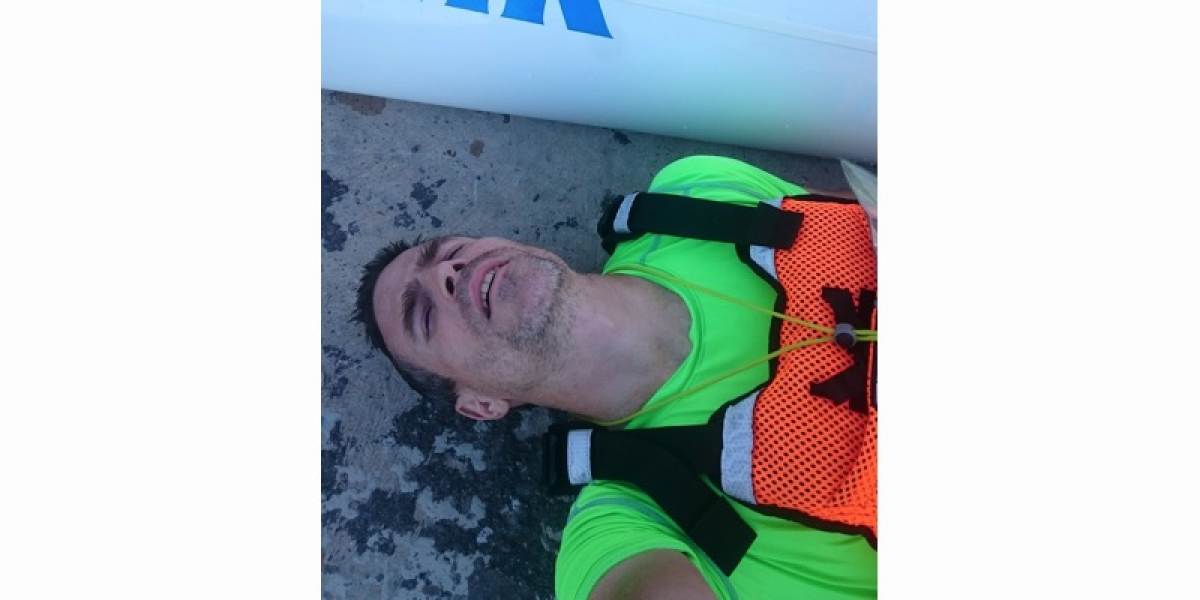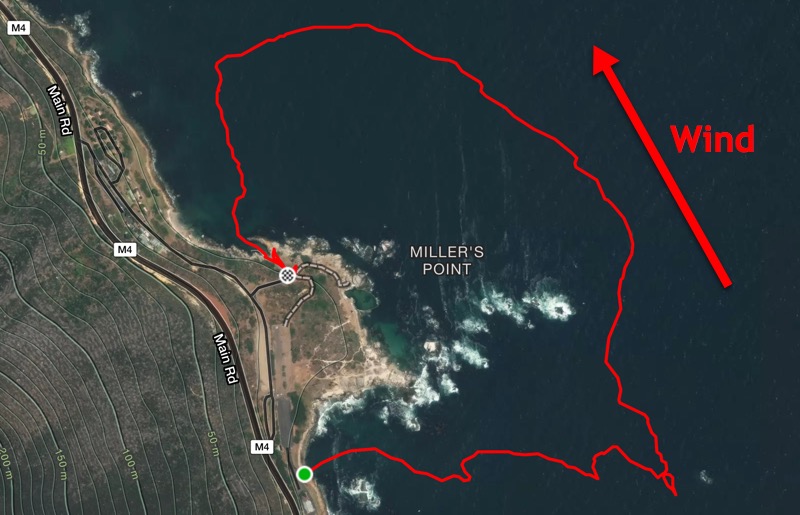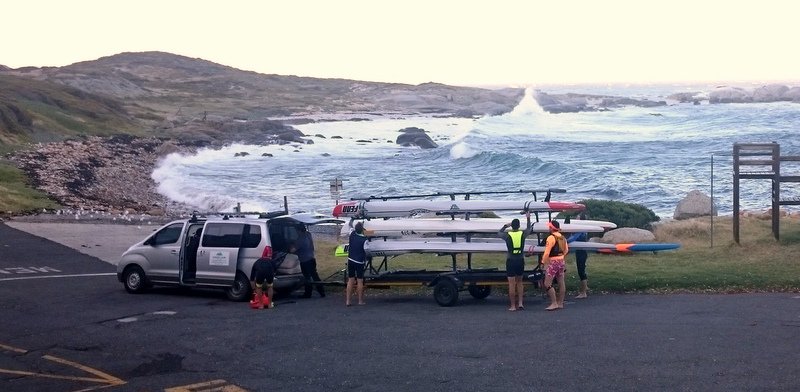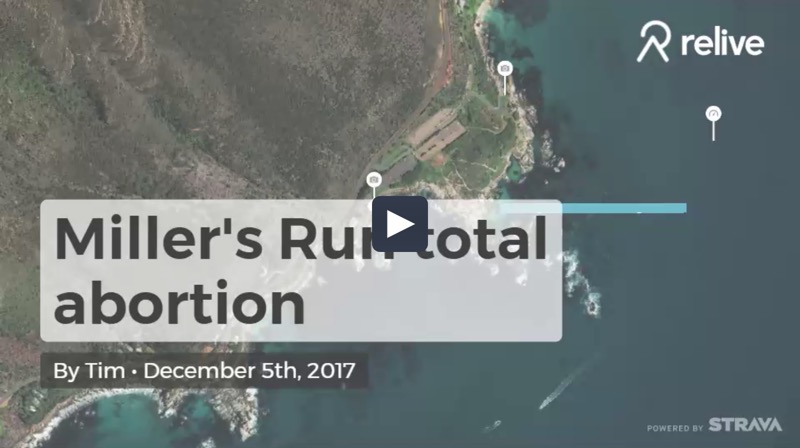Extreme Self-rescue
 Tim Wightman
Credits: Tim Wightman
Tim Wightman
Credits: Tim Wightman
As he fell off his ski yet again, Tim Wightman felt panic starting to well up. If he didn’t get back on and paddling in the next few moments, the gale-force wind and breaking waves would drive him onto the jagged rocks of Miller’s Point. “Calm down!” he yelled to himself. “Take it slowly!” “This time, stay in the f%#$ing boat!”
Tuesday 5th December and the regular evening race in Hout Bay had been cancelled; south-easterly squalls were smashing down the sides of Chapman’s Peak and turning the surface of the bay into a churning maelstrom of whitecaps and spray.
Disappointed, Tim resigned himself to a non-paddling evening at home. But then he had a call. “Come,” his friend Gary said. “Miller’s Run!”
Wild Miller's
(The Miller’s Run is a well-known and much beloved route from Miller’s Point to Fish Hoek along the False Bay coast near Cape Town, South Africa. The most challenging section of the run is the first 800m where the paddlers have to make their way out diagonally into the wind and waves to round Bakoven Rock – which marks the start of the run.)
Tim takes up the story:
“I've been paddling regularly once a week from Three Anchor Bay in Cape Town, but it's been a couple of years since I last did a Miller’s Run,” he said. “The wind was gusting up to 35kts, so there I felt some trepidation, but I pulled the trigger and drove out to Fish Hoek, loaded up onto the Miller's Taxi with Gary and a couple of others.”
The Miller's Run Taxi has made the route much more accessible
The view from the Miller’s Point slipway wasn’t encouraging. As he looked out towards Bakoven Rock, Tim thought it looked, “like an absolute washing machine, with large waves almost breaking all the way out. Coupled with the powerful gusting wind, conditions were going to be testing.”
Rudder Damage
Nervous, he rushed his launch off the slipway, and his rudder grated along the concrete. He didn’t give it a second thought at the time but the impact had bent the shaft, compromising the movement of the rudder.
Not realising what had happened, he paddled out into the storm. The difficulty of paddling diagonally into the wind was compounded by the bigger waves beyond the mouth of the bay. As he crested the swells, the nose of his ski was flung sideways by the wind; once too often and he tipped into the icy water.
“In such conditions, things go pear-shaped pretty quickly,” he said. “It takes some fair amount of energy and concentration to re-mount in gale force conditions and large swell. Add cold to the mix, and a dash of panic with a row of sharp rocks nearby, and it's a recipe for disaster...
“I managed to get things together a couple of times but couldn't seem to control the rudder which was very frustrating. I fell in a few more times, my leg leash getting tangled around the boat and my other leg, making things even more tricky. With each dismount and re-mount my energy dropped lower and my panic levels rose. I had to shout to myself a few times to calm down…”
Injury
“But things were about to get worse. On about the 4th or 5th dismount, I twisted my body and leaned hard over to my left side to avoid falling in again, when I felt a sharp pain and a crunching sound at the base of my rib cage. I released muscle tension and fell into the water. There wasn't much time to work out what happened and so my dismount/remount cycle continued, but with the added spicy ingredient of acute abdominal pain.
“I was getting closer and closer to the rocks and the waves were washing completely over them. My energy was sapping away, muscles were sore, my balance was totally shot and my rib cage was not in a good way. I somehow managed to calm myself and forego use of the rudder pedals, paddling slowly out to sea through the swell with both feet dangling in the water. At this point any thought of finishing the Miller's Run was ancient history, and I was purely focussed on getting myself back to the shore and saving my boat, although I would happily have sacrificed the latter and swum back had the need arisen.”
To his relief he finally managed to paddle his ski beyond the furthest rocks of Miller’s Point itself and turned the ski downwind.
“For a fleeting moment, I entertained an optimistic thought of catching up to the others who were probably already at Roman Rock lighthouse.
“It was then that I understood the problem with the rudder. Each time I tried to steer, the rudder would get stuck, I would need to push harder and harder, until it suddenly released - the result was a swim each time this happened, with resultant rib pain, cold and more loss of energy. At least I was beyond the rocks so the initial danger was now gone. I started eyeing the coastline for a landing spot that would cause the least amount of damage and pain, and steered back into shore.
“At this point I was starting to get the hang of the compromised rudder - by pushing hard with both feet at the same time, and then slightly more with one pedal, I could get it to release in a more controlled fashion and I only swam perhaps twice more. In my calmer state of mind, I also recalled that there was another slipway at Miller's Point on the sheltered side, and I turned south, into the wind, to find it.
“The paddle was uneventful from that point on, although the pain from my ribs was getting more noticeable and I was having to paddle hard directly into the southeaster to get back to the slipway. I made it back, hauled my ski up the ramp and lay down next to it, exhausted.
“After a few minutes, I set my mind to next steps. Here I was, alone at Miller's Point, quite a distance from any houses, and the light was starting to fade. The wind was still howling and being wet to the core, I was starting to shiver uncontrollably, which hurt my ribs even more.

"...sheltering from the wind behind a rock"
Having sent a WhatsApp message to the others, Tim settled down to wait, sheltering from the wind behind a rock. It was almost dark by the time Gary received the message. He hastily changed and hurried back to Miller’s Point. Tim had spent over an hour shivering in his wet gear.
“I arrived home a little after 9pm. Having initially set out at about 4:30pm, that equated to 4.5 hours of driving and dicking around, all for 40 minutes of thrashing about in a cold, tumultuous ocean ending up with a bent rudder and a rib injury. Not my best day out....
Diagnosis: Costochondral Separation
“I had a painful night's sleep - lying down definitely worse than when standing or sitting.
“Gary is a doctor, so he popped round the following morning for a coffee and had a prod around my ribs. He reckons the bottom left rib has separated from the cartilage, which would explain the popping / wrenching feeling I had when the injury occurred.”
https://mddk.com/costochondral-separation.html
“It is quite disconcerting when I roll over in bed,” Tim laughed. “I can feel something moving around as though it's loose... which I guess it is.”
"Relive-ing" the nightmare
https://www.relive.cc/view/1303386297

Tim's GPS track. Bakoven Rock, the starting point of the Miller's Run can be seen lower right.
https://www.strava.com/activities/1303386297
Learnings
Tim said he wouldn’t have done much differently safety-wise. He knew the rudder had scraped over the concrete ramp, but he wasn’t aware that it had actually been damaged until much later.
The others had looked for him at the rock, but had assumed that he’d turned early and headed for Fish Hoek. [Editor: I have been in the same situation – it’s not uncommon that guys struggling to get to the rock turn early. And when it happens, you’re left in an acute dilemma: do you go back towards the ramp, and put yourself back in the danger zone windward of the rocks, or do you assume that the other paddler has turned early? The only solution to this one is to buddy up right from the ramp.]
Tim said, “The recent article on surfski.info about whether to go or not to go in extreme conditions is very pertinent: the conditions last Tuesday, coupled with the time of day (6pm start) as well the fact that I hadn't done a Miller's Run in a couple of years, probably pointed to the fact that I should have considered pulling the pin.
“However at what point do you make that choice? Once you're in the taxi and you get to Miller's, do you decide to keep the ski on the trailer and get driven forlornly back to Fish Hoek? Or do you head out from the slipway and give it a go for a few minutes and turn back if it's too hectic?
“Hard to know what the right answer is, but it helps that there is the other slipway that is sheltered if you have a problem early on and decide to turn back.”



